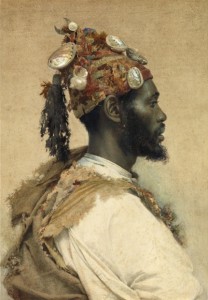
Personally, the exhibition Josep Tapiró. Painter of Tangiers, has been a considerable professional challenge. The major dispersion of the most important works has made the task of finding the works difficult, even though in the end we have managed to bring most of the ones we had counted on at the start. Furthermore, the historical-artistic research about the painter, that we had started to do some time ago, allowed us, in the end, to reconstruct his biography and professional trajectory, as well as documenting some of his most significant works.
At the beginning of everything, in 2001, the memory of this watercolour artist had just about disappeared due to circumstances unrelated to the quality of his artwork. In Tangiers, where he had lived for almost forty years, his memory had faded because of the amnesia the city has suffered in its recent international past, to the extent that finding where his studio had been was to become an authentic odyssey. Therefore, the research of the documentation that has allowed us to reconstruct his trajectory has been a laborious puzzle to solve. It was carried out in Tangiers, Tethuan, Ceuta, Reus, Barcelona, Madrid and London.
Despite the difficulties, as the research progressed, our perception grew of the true dimension of the work of the artist, something that encouraged us to continue the work. To all of this, it should be added that, between 2009 and 2013, an AECID cooperation project was carried out, Tangiers, a world in a city, That consisted of an artistic and architectural inventory of the international diplomatic period. Its development involved continual stays in the north-African city and an exhaustive research, which allowed the necessary information to be found so as to conclude the research work about the artist from Reus. The always receptive Museu Nacional d’Art de Catalunya, aware of the major quality of the work of the painter and in accordance with its function of keeping the art of the country up-to-date, decided then that the completion of the first centenary since his death was the ideal moment to organise a monographic exhibition about this orientalist work.
From that moment on, the organisational work started, which was more than satisfactory, and in human terms a very enriching experience. During the preparation there were some interesting anecdotes, as for example meeting the Tangerine owners of one of the works, whose grandparents had bought the painting from Tapiró himself. Moreover, I was surprised to see the good state of conservation of the work from the Museo del Prado entitled Parache the Dancer . I had contemplated it fifteen years before presiding the living room of the consular residence of Tangiers in a worrying condition.

Josep Tapiró. Parache the Dancer,
c. 1895-1900. Museo Nacional del Prado, Madrid.
These portraits of Sufis and marabouts make us think about the atavistic world that Tapiró had the privilege to witness and that nowadays has disappeared to a great extent.
Sometimes, the painter was more of a documentalist than a creator, his heir, Mesod Benitah, explained that in 1892 he shaved and dressed up as a woman so as to be able to see, hidden, the wedding ritual of Lala Sòdia and afterwards being able to paint her with rigor.
It is worth saying that what has enthused me most, however, was to see the 25 best Tangerine works hung together, something that hadn’t happened since the time of the painter. The result seemed fantastic to me, very striking and a demonstration of the grand scale of this major Catalan artist.
.
Related links
Photo album of the setting up of the exhibition
Restoration of the acquired work of Tapiró
Comissari exposició Tapiró







